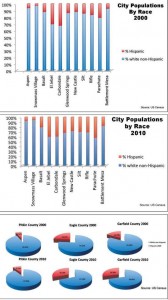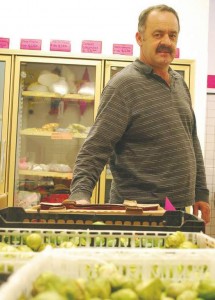
Govany Hernandez, of Carbondale, slices meat at Garcia's market in New Castle, serving to the tastes of a Hispanic population that boomed across the valley. In Carbondale, Hispanics make up nearly 40 percent of the population, according to the 2010 census. David Frey photo.
ASPEN JOURNALISM
Aspen Journalism is an independent nonprofit news organization.
Garfield and Eagle counties are nearly one-third Hispanic. Pitkin County is now 9 percent Hispanic; its Hispanic population grew 60 percent over the decade.
In New Castle, the 15th fastest-growing town overall in the state, the Hispanic population grew from a mere 236 in 2000 to 1,282, a 443 percent change.
Hispanics tripled in Silt and Battlement Mesa and doubled in Snowmass Village, Basalt, Glenwood Springs, Rifle and Parachute.
Gains were more modest in El Jebel and Carbondale, which already had large Hispanic populations, but along with Parachute, those communities are now nearly 40 percent Hispanic.
“I think it’s just part of the way the West is growing these days,” said Steve Rippy, manager of Battlement Mesa Service Association, where growing numbers of blue-collar workers, including construction workers and roughnecks, transformed what had been a quiet retirement community.
“The number of Hispanics in the construction industry really boomed in the last decade,” he said.
Hispanic gains are even greater among children. Anglo children are now in the minority in El Jebel, Glenwood and Parachute. They make up less than 60 percent of young people in New Castle, Silt and Rifle.
The local growth in Hispanics was mirrored statewide. Hispanics weren’t the fastest-growing group in the state; Asians outpaced them. But Hispanic numbers are much higher.
“We are more diverse, and we have been becoming more diverse over the past several decades,” said state demographer Elizabeth Warner.
The biggest growth has been among the under-18 age group, Warner said. The last census showed immigrants moving in. This one shows them settling down. “They have kids, form families,” she said. “That’s where a lot of our growth has been taking place.”
Garcia had plans to open a Mexican restaurant serving cuisine from southern Mexico, where his wife Leticia is from — foods that aren’t on the menu in most Mexican restaurants.
“I tried to open that restaurant last year, but the economy went down, down, and I said, ‘Wait a little bit.’”
He sells basic food, like tacos and burritos, at his lunch counter in the back of the grocery. A few years ago, when the construction industry was booming, the lunch counter was, too.
“Now it’s completely dead,” he said.
Mayor Frank Breslin calls Garcia “the ambassador” of the Latino community.
“If people in general or myself in particular have a question about something or want to get a word in Spanish, we ask Sam,” he said.
Those kind of connections are becoming increasingly important. Breslin said he was surprised to see the census showed the Hispanic population to be so high, but it was no secret that it was growing. He said the town government is seeking a translator to publish its Town Council agendas in Spanish “to invite participation and show that we respect that population.”



